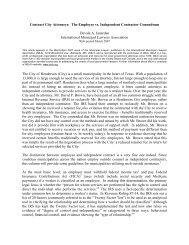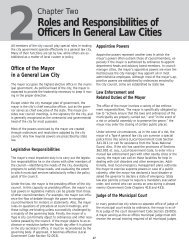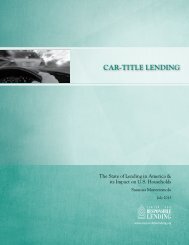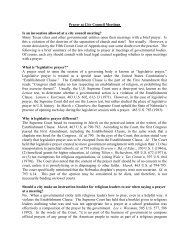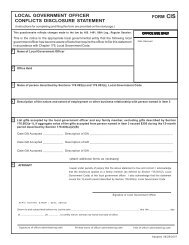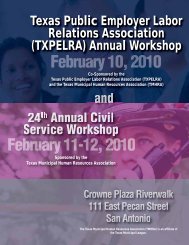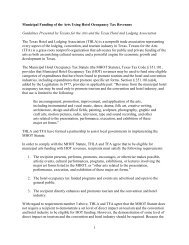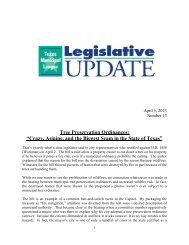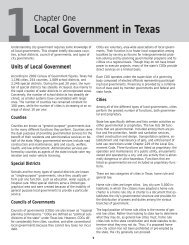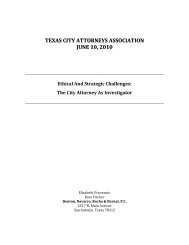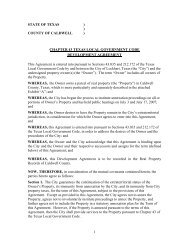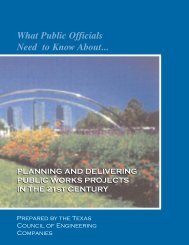Economic Development Basics - Texas Municipal League
Economic Development Basics - Texas Municipal League
Economic Development Basics - Texas Municipal League
You also want an ePaper? Increase the reach of your titles
YUMPU automatically turns print PDFs into web optimized ePapers that Google loves.
3. Land as an <strong>Economic</strong> <strong>Development</strong> Tool..........................................E. Districts Commonly Created in <strong>Municipal</strong>ities .............................................1. Public Improvement District Assessment ActTex. Loc. Gov’t Code Ann. Ch. 372 (Vernon 1999 & Supp.2004) ..................................................................................................2. <strong>Municipal</strong> Management DistrictsTex. Loc. Gov’t Code Ann. Ch. 375 and Ch. 376 (Vernon1999 & Supp. 2004)...........................................................................(ii)
BASICS REGARDING STATUTORY ECONOMIC DEVELOPMENTTOOLSFOR MUNICIPAL ATTORNEYSFebruary 27, 2004A. <strong>Economic</strong> <strong>Development</strong> GoalsI.GENERAL BACKGROUND FOR CONSIDERINGECONOMIC DEVELOPMENT INCENTIVESArticle III Section 52-a of the <strong>Texas</strong> Constitution, adopted November 3, 1987, is titled,"Assistance to encourage state economic development," and declares that the followingtypical economic development goals are public purposes: development and diversification ofthe economy, the elimination of unemployment or underemployment, the stimulation ofagricultural innovation, the fostering of the growth of enterprises based on agriculture, or thedevelopment or expansion of transportation or commerce. Various economic developmentstatutes state additional objectives such as retention or expansion of primary employmentand attracting major investment to a particular area. <strong>Economic</strong> development incentivesshould be structured in a way to successfully achieve one or more of the goals stated in theauthorizing statutes. For practice pointers and public purpose considerations relating toeconomic development incentives, see Attachment 1 to this paper.B. What is a city’s role in economic development?In working to successfully promote economic development, a city’s role is much larger thanoffering incentives. For instance, consider the role favorable "soft infrastructure" might playin your city’s economic development efforts. The term "soft infrastructure" includes suchthings as the regulatory structure, availability of adequate workers, quality of life in thecommunity, educational opportunities, and friendliness toward business. The term"friendliness toward business" may include such things as availability of financing,availability of non-profit agencies to assist with business support and training, andavailability of transportation for employees. Favorable soft infrastructure is likely to involvecollaboration of businesses, government, and educational institutions to create an effectivebusiness environment based on the needs and demands of the particular industries andentities involved and those they serve. Each community is likely to have different needs andassets to consider when building the city’s soft infrastructure.In summary, well-managed city services, carefully planned and maintained infrastructure,fair and efficient regulatory policies, and well-planned, effective land use policies are allexamples of a municipality’s role in promoting the greatest gains for citizens as a wholethrough its efforts to promote economic development. 1II.STATUTORY TOOLS TO PROMOTE ECONOMIC DEVELOPMENTA. <strong>Economic</strong> <strong>Development</strong> Sales and Use Taxes1. 4A and 4B Sales TaxTex. Rev. Civ. Stat. Ann., art. 5190.6 § 4A and § 4B (Vernon Supp. 2004) [Hereafterreferred to simply as 4A and 4B]1 NORTH, DOUGLAS C., STRUCTURE AND CHANGE IN ECONOMIC HISTORY 24 (W.W.Norton & Co. 1981).(3)
a. What is it? Sections 4A and 4B of the Industrial <strong>Development</strong> CorporationAct allow voters in eligible cities to approve a local sales and use taxdedicated to promoting economic development projects as delineated in thestatute. House Bill 2912, passed during the 2003 regular session, amends theIndustrial <strong>Development</strong> Corporation Act to place additional restrictions onthe way the 4A and 4B sales taxes can be used. The Senate CommitteeReport regarding House Bill 2912 states the purpose of the amendment is torefocus the use of the economic development sales tax on the creation orretention of primary jobs. Among other restrictions, the 2003 revisionprohibits a 4A or 4B corporation from providing a direct incentive or makingan expenditure on behalf of a business unless the economic developmentcorporation and the business enterprise enter into a performance agreementwhich at a minimum must provide a schedule of additional payroll or jobs tobe created or retained and capital investment to be made as consideration forany direct incentives provided. The performance agreement must alsospecify the terms under which repayment must be made if the businessenterprise fails to meet the performance requirements specified in theagreement. Tex. Rev. Civ. Stat. Ann. art. 5190.6 § 40 (Vernon Supp. 2004).b. What is the benefit to the City? Provides a funding source for projects.Authorizes the issuance of bonds and other obligations funded by sales tax.4A and 4B corporations are not political subdivisions subject to notice andbid requirements applicable to the sale or exchange of land. Op. Tex. Att'yGen. No. JC-109 (1999).(1) How do you know whether you should establish a 4A or 4Bcorporation?Size of CountyThe rule of thumb has historically been that smaller cities have 4Acorporations and larger cities have 4B corporations. The line is not asclear now.In 1993, the legislature made 4B available to any city eligible to adopta 4A sales tax. Therefore, most cities in a county of less than 500,000can adopt either the 4A or the 4B sales tax, or both, if they have notreached their local sales tax limit.To be eligible to create a 4B corporation, a city must be located in acounty with a population of 500,000 or more in which the combinedrate of all sales and use taxes does not exceed 8.25 percent; or the citymust have a population of 400,000 or more and be located in morethan one county in which the combined rate of all sales and use taxesimposed does not exceed 8.25 percent; or the city must meet therequirements of Section 4A.Type of ProjectProjects listed in Tex. Rev. Civ. Stat. Ann. art. 5190.6, § 2(11)(A)(Vernon Supp. 2004) are authorized for both 4A and 4B corporations,although certain additional restrictions may apply under either 4A or4B. In the following definition of “project” the words added by the78th legislature and effective June 2003 are underlined. According to(4)
§ 2(11)(A), the term “project” means “the land, buildings, equipment,facilities, expenditures, targeted infrastructure, and improvements(one or more) that are for the creation or retention of primary jobs andthat are 2 found by the board of directors to be required or suitable forthe development, retention, or expansion of manufacturing andindustrial facilities, research and development facilities, transportationfacilities (including but not limited to airports, ports, mass commutingfacilities, and parking facilities, sewage or solid waste disposalfacilities, recycling facilities, air or water pollution control facilities,facilities for the furnishing of water to the general public, distributioncenters, small warehouse facilities capable of serving as decentralizedstorage and distribution centers, primary job training facilities for useby institutions of higher education, and regional or national corporateheadquarters facilities."The types of projects a 4A corporation may undertake are restrictedby Art. 5190.6, § 4A(i), which clarifies the primary purpose of aproject may not be to provide transportation facilities, solid wastedisposal facilities, sewage facilities, facilities for furnishing water tothe general public, or air or water pollution control facilities. A 4Acorporation may provide these types of facilities to benefit a projecthaving another primary purpose permitted by the statute.A permissible 4A and 4B “project” also includes job training requiredor suitable for the promotion of development and expansion ofbusiness enterprises and other enterprises described by the<strong>Development</strong> Corporation Act, but only if the business enterpriseseeking 4A or 4B job training funds makes certain commitments inwriting regarding the wages of the jobs created. Tex. Rev. Civ. Stat.Ann. Art. 5190.6, § 38(b) (Vernon Supp. 2004).Effective 2003, a 4A or 4B corporation may not provide a directincentive to or make an expenditure on behalf of a business enterpriseunder a project unless the corporation enters into a performanceagreement with the business enterprise containing the provisionsdelineated in the statute. Tex. Rev. Civ. Stat. Ann. Art. 5190.6, § 40(Vernon Supp. 2004).4B authorizes the same type projects authorized by 4A, butadditionally authorizes projects such as land, buildings or equipmentfor professional and amateur sports facilities, park facilities andevents, entertainment and tourist facilities, and affordable housing.As of September 1, 2001, a 4B project may also include research anddevelopment facilities, and a water supply or water conservationprogram. As of 2003, a water supply or water conservation programmust be specifically approved at an election utilizing the ballotlanguage added by § 4B(a-5)(1).2The words “to promote new and expanded business development” were deleted from the definition of “project.”(5)
Other differencesA 4A sales tax may be adopted in conjunction with a sales tax forproperty tax relief under one proposition. There is no authorizationfor a proposition combining a 4B sales tax with a sales tax forproperty tax relief.Once adopted, the 4A tax continues until repealed at an election. The4B tax continues until the bonds and any other debt obligations havebeen paid in full for all of the projects undertaken by the 4Bcorporation.A 4A sales tax is authorized through use of mandatory wording forthe ballot proposition. There is no required statutory language for the4B ballot proposition. It can be authorized by a general ballotproposition for the adoption of a 4B sales tax for economicdevelopment. A Chapter 334 venue sales tax (or other fundingoptions) is authorized through use of mandatory wording for theballot proposition.There is no statutory authority for a 4B tax rate to be increased orreduced at subsequent elections. A 4A tax may be reduced, increasedor repealed at an election held on the issue. The election to increaseor decrease a 4A tax may be called on a city’s own motion or onpetition of at least 10 percent of the registered voters of the city. AChapter 334 venue sales tax may be decreased by ordinance of thecity. To increase the Chapter 334 venue sales tax would require anelection.Prior to proceeding with a project, both 4A and 4B corporation boardsare required to obtain approval of the municipality’s governing body.A 4A corporation is not required to conduct additional public noticeor public hearings on 4A projects. However, 4B corporations mustprovide public notice and hold a public hearing prior to undertaking aproject. The public has sixty days to petition for an election onwhether to pursue the project if it is not a project already approved bythe voters.2. Sports and Community Venue Sales Tax and Other Revenue SourcesTex. Loc. Gov't Code Ann. Ch. 334 (Vernon 1999 & Supp. 2004)a. What is a venue under Chapter 334?(1) An arena, coliseum, stadium, or other type of area or facility forwhich a fee for admission is charged.(2) A convention center, facility or related improvement such as a civiccenter, civic center hotel, auditorium, theater, opera house, music hall,exhibition hall, rehearsal hall, park, zoological park, museum,aquarium, or plaza located in the vicinity of a convention center orfacility owned by a city.(3) A tourist development area along an inland waterway.(6)
(4) A municipal parks and recreation system, or improvements oradditions to a park or recreation system, or an area or facility that ispart of a municipal parks and recreation system. (The provisionregarding municipal parks was added in 1999.)(5) A project authorized by art. 5190.6, § 4A or § 4B, as that Act existedon September 1, 1997.(6) A watershed protection and preservation project; a recharge, rechargearea, or recharge feature protection project; a conservation easement;or an open-space preservation program intended to protect water.A "venue project" means a "venue" and related infrastructure, planned,acquired, established, developed, constructed, or renovated under Chapter334.b. What is the funding source?(1) Sales and Use Tax Increase up to 1/2 of 1% (§ 334.081)Must be in increments of either 1/8, 1/4, 3/8, or 1/2 of 1%.Provides for reduction of tax rates if adoption of this sales tax wouldresult in a combined sales and use tax rate in excess of 2% in anylocation in the county or municipality.(2) Short-Term Motor Vehicle Rental Tax (§ 334.102)Rental of 30 days or less.Increments of 1/8 of 1%, and may not exceed 5%.May not be used to fund a municipal park and recreation systemvenue.Cannot be imposed after bonds or other obligations for the project arepaid in full.(3) Admissions Tax (§ 334.151)Imposed on each ticket sold as admission to an event held at anapproved venue project if bonds have been issued for the project, butonly during the time the bonds remain unpaid.City may decrease or repeal amount by ordinance.City may increase amount by ordinance if approved at an election.Must not exceed 10% of the price of the ticket under anycircumstances.(7)
(4) Parking Tax (§ 334.201)Imposed on each motor vehicle parking in a parking facility of anapproved venue project within a period 3 hours before and 3 hoursafter an event.Imposed as a flat amount on each vehicle or as a % of the amountcharged for event parking, not to exceed $3 per vehicle.May be used only if bonds have been issued and are outstanding.(5) Hotel Occupancy Tax (§ 334.252)May not exceed 2% of the price paid for the room.Is in addition to the 6% tax already in effect.May impose this tax only if bonds are issued and only while the bondsare unpaid.May not use for venue project that is part of municipal park system.(6) Facility Use Tax (§ 334.302)A uniform amount not to exceed $5,000 imposed on each member ofa professional sports team for each professional game the memberplays at the approved venue project.May impose this tax only if bonds are issued and only while the bondsare unpaid.(7) Bonds and Other ObligationsA city may issue bonds to pay the costs of the project.The bonds must be payable from and secured by the revenues in thevenue project fund.The bonds may mature serially or otherwise not more than 30 yearsfrom their date of issuance.The bonds are not a debt of and do not create a claim against therevenue or property of the city other than the revenue sources pledgedand an approved venue project for which the bonds are issued.c. For what purposes can the funds collected pursuant to Chapter 334 be used?The revenues are placed into a venue project fund. The fund can be spent to:(1) Reimburse or pay the costs of planning, acquiring, establishing,developing, constructing, or renovating one or more approved venueprojects.(8)
(2) Pay the principal of, interest on, and other costs relating to bonds orother obligations issued by the city to refund bonds, notes, or otherobligations.(3) Pay the costs of operating or maintaining one or more approved venueprojects.d. What is the benefit to the city of using Chapter 334?B. "Quality of Life" TaxesThe law creates new funding sources for projects with the potential to createadditional revenue for the sponsoring cities. The law is especially beneficialto cities that have reached their local sales tax cap and need additionalrevenue sources. The types of projects permitted under Chapter 334 areprojects that attract visitors to the venue itself as well as to surroundinghotels, restaurants and shops. It is also likely that a venue project will bringnew sources of ad valorem tax revenues to the city through new businessesattracted to the vicinity of the venue. Ideally, additional visitors and newbusinesses will lead to an increase in sales tax revenue to the city's generalfund to pay the costs of running the city (i.e. streets, police, fire, codeenforcement). The venue project funding options authorized by the statuteare the type that will be at least partially funded by the persons visiting thevenues. 31. Local Hotel Occupancy TaxTex. Tax Code Ann. Ch. 351 (Vernon 2002 & Supp. 2004).a. What is the local hotel occupancy tax?A hotel occupancy tax may be imposed against any person who pays for theuse of a room in a hotel. Most cities are eligible to adopt a hotel occupancytax rate of up to seven percent of the consideration paid for the use of a hotelroom. Certain cities, by statute, may impose a hotel occupancy tax at ahigher rate (§ 351.003). The state of <strong>Texas</strong> imposes a six percent hoteloccupancy tax rate. Additionally, a number of counties have receivedlegislative approval to adopt a county hotel occupancy tax not to exceedseven percent of the consideration paid for a hotel room. In certain areas of<strong>Texas</strong>, the combined hotel occupancy tax rate of up to 20 percent of the costof the hotel room may be charged. Hotels are required to charge and collectthe tax, and the hotel remits the tax to the city on a regular basis establishedby the city.b. How is the local hotel occupancy tax imposed?Cities may adopt an ordinance calling for the levy of the tax. Voter approvalis not required, except for a general-law municipality that borders on the Gulfof Mexico and has a boundary that is within 30 miles of Mexico. In thatinstance, the city may increase the rate to a maximum of 7.5 percent if theincrease is approved by a majority of the registered voters voting at theelection held for that purpose. See Tex. Tax Code Ann. § 351.003(d)(Vernon 2004 Supp.) effective June 18, 2003 until January 1, 2006.3 For a comparison of Tex. Civ. Statutes art. 5190.6 § 4B vs. Loc. Gov't Code Chapter 334, see Attachment 2.(9)
c. How can the hotel occupancy tax be used?(1) In order to be valid, the hotel occupancy tax expenditure must directlyenhance and promote tourism and the convention and hotel industry.The hotel occupancy tax may not be used for general revenuepurposes unless directly related to increasing tourism.(2) Additionally, local hotel occupancy tax revenues may be used onlyfor expenditures that fit into one of six categories. Briefly stated,these categories are: convention centers, registration of conventiondelegates, advertising and promotion of the city, promotion of thearts, historical preservation, or certain sporting events in eligiblecities.(3) <strong>Texas</strong> law also imposes restrictions on the percentage of hoteloccupancy tax revenues that may be spent on each of the sixcategories listed above. The restrictions differ based on population ofthe city. Additionally, special legislative provisions apply to certaincities. The Attorney General Handbook on <strong>Economic</strong> <strong>Development</strong>Laws for <strong>Texas</strong> Cities contains a concise statement of the percentagelimitations.(4) Effective September 1, 2001, before expending hotel occupancy taxrevenues, a city must list each scheduled activity, program, or eventthat is directly funded by hotel occupancy tax proceeds or has itsadministrative costs funded in whole or in part by the tax. Eachactivity, program or event must directly relate to enhancing andpromoting tourism and the convention and hotel industry.(5) Since 1999, cities have been required to keep track of hoteloccupancy tax revenues collected and expended, which includesinterest earned on the hotel occupancy tax revenues.2. Street Maintenance Sales TaxTex. Tax Code Ann. Ch. 327 (Vernon 2002 & Supp. 2004)a. What the street maintenance sales tax?A street maintenance sales and use tax at a rate of 1/8 or 1/4 of one percentmay be used only for the maintenance and repair of municipal streets existingat the time the sales tax is approved.b. Is an election required?Yes. The sales tax must be approved at an election.c. How can the street maintenance sales tax be used?The tax may be used only for maintenance and repair of municipal streetsexisting at the time of the sales tax election. The statute does not define“maintenance and repair.” The statute defines “municipal street” as, “theentire width of a way held by a municipality in fee or easement or dedicationthat has a part open for public use for vehicular travel.” It sounds simpleenough, but expect many questions about what can be paid from the sales tax.(10)
Capital expenditures may be justified if they are essential to carrying out thepurpose of the statute.d. What is the duration of the tax?The sales tax expires four years from the date it takes effect unlessreauthorized by voters prior to its expiration. If the tax is not reauthorizedprior to its expiration, the tax expires and the city may not call an election onthe question of authorizing a new tax before the first anniversary of theexpiration date.3. Crime Control and Prevention Sales and Use TaxTex. Loc. Gov’t Code Ann. Ch. 363 (Vernon 1999 & Supp. 2004).a. What is the Crime Control and Prevention Sales and Use Tax?At an election for the purpose of creating and funding a Crime Control andPrevention District, a sales and use tax may be authorized in increments of1/8 cent up to a maximum of 1/2 cent.b. Is an election required?Yes. The election must be held on a uniform election date. However, theelection is held under Chapter 323 of the Tax Code; therefore, as of the dateof this paper, the one-year limitation on the frequency of sales tax electionsfound in Tax Code Chapter 321 is not applicable.c. How can the crime control and prevention sales and use tax be used?A temporary Board must be appointed by the city council. The board mustformulate and approve a two year budget plan and a two year crime controlplan to be approved by the voters in summary form. The sales and use taxmay be used to pay for all costs of the approved crime control and preventionprogram, including the costs of personnel, administration, expansion,enhancement, and capital expenditures. The board must reimburse the cityfor expenses incurred in creation of the district. The board may not issue orsell general obligation bonds, revenue bonds, or refunding bonds. Additionallimitations on expenditures and investments are found in Tex. Loc. Gov’tCode § 363.206 (Vernon Supp. 2004).d. What is the duration of the district?C. Ad Valorem Tax ToolsThe district dissolves after five years unless voters approve its continuation.The city or the board may specify continuation of 5, 10, 15, or 20 years, andthe district is dissolved at the end of the period for which it is continuedunder § 363.2515. See Tex. Loc. Gov't Code Ann. (Vernon Supp. 2004)§ 363.301.1. Tax AbatementTex. Tax Code Ann. Ch. 312 (Vernon 2002 & Supp. 2004).(11)
a. What is tax abatement? An exemption of all or a portion of the value ofadded taxable real property improvements or personal propertyimprovements.b. What is the funding source? An ad valorem tax exemption for all or a portionof taxable value added by a project for a period not to exceed ten years.c. What is the benefit to the municipality? Ideally, the abatement inducesdevelopment, adds value to the tax roll, and creates employmentopportunities that would otherwise not occur. Even though a portion of thetaxes on the added value will not come into the municipal coffers during thelife of the tax abatement agreement, jobs will be created and local businessesare likely to benefit from construction of the project. In most instances, thepublic will benefit from additional employment opportunities. The city willbenefit from the additional taxes received on a portion of the added value(unless a 100% abatement is granted) during the life of the agreement. Afterthe agreement expires, the project’s added value and employmentopportunities should continue to benefit the city.(1) Actions of the governing body required prior to granting taxabatement:(a)Must adopt a resolution indicating intent to participate in taxabatement (312.002).(b) Must adopt tax abatement guidelines and criteria (312.002).(c) Must designate an area as a reinvestment zone (312.201).(d)A tax abatement agreement must be approved by a majority ofthe members of the governing body at a regularly scheduledmeeting (312.207) and the agreement must contain thefollowing [312.205 (a) (1) – (7)]:(i)(ii)(iii)(iv)(v)(vi)(vii)Description of proposed improvements.Authority to inspect to determine compliance.Limit the uses of the property.Provide for recapturing property tax revenue lost.Contain each term agreed to by the owner of theproperty.Require annual certification of compliance by owner.Provide for cancellation or modification for failure tocomply with the agreement.d. Findings of the governing body required prior to granting tax abatement:(1) Prior to adopting an ordinance designating an area as a reinvestmentzone, the governing body must hold a public hearing and find that theimprovements sought are feasible and practical and would be a(12)
enefit to the land to be included in the zone and to the municipalityafter the expiration of a tax abatement agreement. [§ 312.201(d)](2) To be designated as a reinvestment zone, an area should bedetermined by the governing body to meet one of the six criteria listedin § 312.202.(3) Prior to authorizing a tax abatement agreement, the governing bodymust find that the terms of the agreement and the property subject tothe agreement meet the applicable guidelines and criteria adopted bythe governing body. [§ 312.002(b)]2. Tax Increment FinancingTex. Tax Code Ann. Ch. 311 (Vernon 2002 & Supp. 2004).a. What is tax increment financing? Tax increment financing is a tool tofinance public improvements within a defined area. The improvementsshould enhance the area and attract new investment. A municipality makesan area eligible for tax increment financing by designating a "reinvestmentzone," also called a "tax increment reinvestment zone," "TIRZ" or a "TIFzone." Costs of selected public improvements within the reinvestment zone("Zone") may be paid by current or future tax revenues flowing fromredeveloped or appreciated real properties in the zone. The additional taxdollars generated by growth of real property value in the Zone are called thetax increment. These dollars flow to a tax increment fund ("Fund") for aspecified term of years. Money flowing to the Fund each year is disbursedaccording to a plan and agreements approved by a Board appointed byparticipating local governmental units, as set by the ordinance designating theZone.b. What is the funding source? Additional tax dollars generated by growth ofreal property value in the zone.c. What is the benefit to the municipality? Tax increment financing comes witha built-in funding source in areas where taxable values are increasing. Themoney can only be used for public improvements described in themunicipality’s project plan.d. Initial requirements:(1) Must be initiated by petition of affected property owners or by thegoverning body of the municipality.(2) If initiated by the governing body, a finding should be made that thearea considered for tax increment financing meets at least one of thethree criteria listed in § 311.005(a)(1)-(3):(a)The area's present condition must substantially impair thecity's growth, retard the provision of housing, or constitute aneconomic or social liability to the public health, safety,morals, or welfare. Further, this condition must exist becauseof the presence of one or more of the following conditions: asubstantial number of substandard or deteriorating structures,inadequate sidewalks or street layout, faulty lot layouts,unsanitary or unsafe conditions, a tax or special assessment(13)
delinquency that exceeds the fair market value of the land;defective or unusual conditions of title, or conditions thatendanger life or property by fire or other cause; or(b)(c)The area is predominately open, and because of obsoleteplatting, deteriorating structures, or other factors, itsubstantially impairs the growth of the city; orThe area is in or adjacent to a "Federally assisted newcommunity" as defined under Tax Code § 311.005(b).(3) The Tax Code imposes several additional requirements on areinvestment zone for tax increment financing.(a)(b)(c)No more than 10 percent of the property within thereinvestment zone (excluding publicly-owned property) maybe used for residential purposes. This requirement, however,does not apply if the district is created pursuant to a petition ofthe landowners.A reinvestment zone may not contain property thatcumulatively would exceed 15 percent of the total appraisedproperty value within the city and its industrial districts.A city also may not create a reinvestment zone or change theboundaries of an existing zone if the zone would contain morethan 15 percent of the total appraised value of real propertytaxable by a county or school district.D. Miscellaneous Statutory Tools(4) The governing body must prepare a preliminary reinvestment zonefinancing plan. The Tax Code does not specify the contents of thepreliminary financing plan but a city may find it beneficial to includeeach item required for the final financing plan described in Tax Code§ 311.011.1. Chapter 380 <strong>Economic</strong> <strong>Development</strong> ProgramsTex. Loc. Gov’t Code Ann. Ch. 380 (Vernon 1999 & Supp. 2004).a. What is Local Government Code Chapter 380? Chapter 380 of the LocalGovernment Code was enacted pursuant to art. III, § 52-a of the <strong>Texas</strong>Constitution, which provides that economic development is a public purpose.According to a 1992 attorney general’s opinion, "The legislature intended§ 380.01 to authorize municipalities to offer a range of incentives designed topromote state or local economic development." Op. Tex. Att'y Gen. No.DM-185 (1992).b. What is the funding source? The statute authorizes grants and loans from cityfunds for economic development purposes, but does not specifically providefor a specific tax or fee to fund the grants and loans.A home-rule municipality may issue bonds to fund an economic developmentprogram that the municipality has established in accordance with § 380.001,but only if two conditions are met. (1) The bonds must be in an amount and(14)
to the extent provided by the municipality’s charter. (2) A majority of thequalified property tax-paying voters voting at an election held to consider thebond issue must have approved the issuance. Op. Tex. Att'y Gen. No. DM-185 (1992). Funds granted under § 380.002 to a § 501(2)(3) corporation or adevelopment corporation under art. 5190.6 cannot be from the proceeds ofbonds or other obligations of the municipality payable from ad valorem taxes.Make sure the intended use of funds is consistent with the authorizedpurposes of the funds. For instance, hotel occupancy tax can be used only forcertain purposes. Funds from a 4A or 4B sales tax can be used only forcertain purposes. All statutes and "contracts with the voters" applicable to aparticular funding source should be evaluated prior to obligating the funds.The statute also authorizes the use of city staff, city facilities, or city servicesat minimal or no charge, but the safeguards discussed below should beutilized to avoid an allegation of a donation of public property. See Op. Tex.Att'y Gen. No. JC-0109 (1999).c. What is the benefit to the City from utilizing Chapter 380? Flexibility tostructure a program to meet the needs of the city for a particular project.d. Initial Requirements:(1) Establish a program. The statute does not define the term "program."In order to meet the constitutional requirement that a public purpose isserved by the expenditure of public funds or the provision of publicservices, the program should be planned and described in a writtendocument that includes at least the minimal safeguards to achieve thepublic purpose of economic development. The minimum safeguardsare:(a)(b)(c)(d)Written agreement.Outline the steps the business must take to justify publicfunding; for instance, creation of jobs or the expansion of thetax base by construction or enhancement of real propertyimprovements.Provide for the recapture of incentives provided if the businessdoes not meet its obligations.Provide an effective method for measuring whether theindustry has met its obligations.(2) Comply with Budget law contained in Chapter 102 of the LocalGovernment Code.(3) Comply with <strong>Municipal</strong> Charter for limitations on expenditures.e. Required Findings:That the public purpose of economic development will be accomplishedthrough the program.(15)
That there will be a demonstrable benefit to the municipality from use of theincentives.That sufficient safeguards are in place to determine whether a business hasmet its obligations, and if the obligations have not been met, that theincentives granted can be recaptured.See Op. Tex. Att'y Gen. No. DM-185 (1992) regarding the constitutionality ofChapter 380.2. Local Government CorporationsTex. Transp. Code Ann. § 431.101 (Vernon Supp. 2004); also applicable, Tex. Loc.Gov’t Code Ann. Ch. 394 (Vernon 1999).a. What is a Local Government Corporation?A local government corporation is a non-profit corporation created to aid andact on behalf of one or more local governments to accomplish anygovernmental purpose of those local governments. Tex. Transp. Code Ann.§ 431.101(a) (Vernon Supp. 2004). If the city chooses to create a localgovernment corporation, the city must approve by ordinance or resolution thearticles of incorporation and the bylaws of the corporation. The city isentitled to any income earned by the local government corporation that is notneeded to pay the corporation’s expenses or obligations. The localgovernment corporation is subject to the Public Information Act and theOpen Meetings Act (Transp. Code §§ 431.003, 431.004, 431.005) and mayissue bonds and notes, but does not have taxing authority. The corporation isdissolved when the purposes of the corporation are fulfilled and allobligations of the corporation have been fully paid. On dissolution orliquidation of a corporation created by a city, the title to all assets shall betransferred to the city. Tex. Trans. Code Ann. § 431.186 (Vernon 1999).b. What is the funding source?The corporation may issue bonds and notes. [Transp. Code §§ 431.070;431.101(b)]A corporation may borrow money to meet any expense or need associatedwith the operation of the corporation. [Transp. Code §§ 431.065; 431.101(b)].Additionally, a home-rule municipality with a population of more than100,000 may create programs for the grant of public money to the localgovernment corporation, as an organization exempt from taxation asdescribed in Tex. Loc. Gov’t Code Ann. § 380.002(a). The funds granted bythe municipality may be derived from any source lawfully available to themunicipality, other than from the proceeds of bonds or other obligations ofthe municipality payable from ad valorem taxes. For instance, the grant maybe made from a revenue source approved by the voters for a sports andcommunity venue project authorized by Loc. Gov’t Code Ch. 334 or 335.c. What is the benefit to the city of using a local government corporation?Reasons stated by governmental entities for using local governmentcorporations include:(16)
(1) Greater flexibility in negotiating and awarding contracts related to thedevelopment of a municipal project carried out by the corporation.Except in limited circumstances involving navigation districts, localgovernment corporations are not subject to Professional ServicesProcurement Act or competitive bidding requirements. [Transp. Code§ 431.101(e) and (g); Tex. Attorney General Opinion, JC-0335(2001)].(2) One or more governmental entities may contract under Chapter 431for a shared project. Chapter 431 puts all entities on an equal playingfield because they are each operating under the broad authoritygranted under Chapter 431. The local government corporationreceives funding from each entity in accordance with an agreementamong the entities, and a board carries out the project on behalf of theentities. The board may include members of the various governingbodies of the governmental units creating the corporation.(3) Local Government Code Chapter 334 and 335 authorizing sports andcommunity venue projects does not require or specifically provide forthe creation of a corporation as Tex. Civ. Statutes art. 5190.6, § 4Aand § 4B do. The city (or county) may choose to carry out all aspectsof a Chapter 334 or Chapter 335 project. However, in certaininstances, the city (or county) may find it beneficial to enter into acontract with a local government corporation to construct, own, leaseand/or operate a sports and community venue project. For instance,the city may prefer that the local government corporation issue bondsfor the project and act as the owner and lessor of a project.(4) If the city wants to transfer land to a local government corporation tocarry out a project on behalf of the city, Loc. Gov't Code § 253.011provides that land may be transferred to a nonprofit organization(such as a local government corporation) without complying with thenotice and bidding requirements of Loc. Gov't Code § 272.001(1) orother law provided the organization is required to use the property toprimarily promote a public purpose of the city, and provided that theproperty is conveyed by instrument that indicates the ownership of theproperty automatically reverts to the city if the nonprofit organizationat any time fails to use the property as required.d. Examples of current uses of local government corporations.(1) Two cities created a local government corporation to acquire,construct and operate a water utility system.(2) Four cities and a county created a local government corporation toown, fund and operate a performing arts facility.(3) A county created a local government corporation to contract with asports and community venue district for construction of a stadium foran NFL expansion franchise.(4) A city created a local government corporation to construct, operate,maintain and obtain project based financing for a convention centerhotel.(17)
(5) Tax Increment Reinvestment Zone (TIRZ or TIF) boards and<strong>Municipal</strong> Management District boards sometimes choose to utilize alocal government corporation to manage revenues and project plans.The powers of the local government corporation are more clearlydefined and broader than the powers provided by statute for the taxincrement reinvestment zone board.3. Land as an <strong>Economic</strong> <strong>Development</strong> ToolIs a city or a 4A or 4B corporation authorized to use land as an economicdevelopment tool by donating or selling the land at a reduced price for economicdevelopment purposes?a. Notice and Bid Requirements(1) General Rule: Notice and bids are required before a politicalsubdivision (including a City) may sell real property unless the salefits within an exception. Tex. Loc. Gov't Code Ann. § 272.001(Vernon Supp. 2003).(2) Exceptions:(a)Tex. Loc. Gov't Code Ann. § 272.001(b)(1)-(7) (Vernon Supp.2004).(i)(ii)(iii)(iv)(v)(vi)narrow strips of land, or land that because of itsshape, lack of access to public roads, or small areacannot be used independently under its currentzoning or under applicable subdivision or otherdevelopment control ordinances;streets or alleys, owned in fee or used by easement;land or a real property interest originally acquiredfor streets, rights-of-way, or easements that thepolitical subdivison chooses to exchange for otherland to be used for streets, rights-of-way,easements, or other public purposes, includingtransactions partly for cash;land that the political subdivision wants to havedeveloped by contract with an independentfoundation;a real property interest conveyed to a governmentalentity that has the power of eminent domain;a municipality's land that is located in areinvestment zone designated as provided by lawand that the municipality desires to have developed(18)
under a project plan adopted by the municipalityfor the zone; or(vii)a property interest owned by a defense basedevelopment authority.(b)4A, 4B corporationsb. Fair Market ValueStatute to consider:Not a political subdivision and not subject to notice and bidrequirement contained in Loc. Gov't Code § 272.001. Op.Tex. Att'y Gen. No. JC-109 (1999).Loc. Gov't Code § 253.011 provides that a city may transfer real property oran interest in real property to a non-profit corporation without complyingwith notice and bid requirements if an agreement requires the non-profit touse the property in a manner that primarily promotes a public purpose of themunicipality. The statute also states that such a contract is adequateconsideration. The conveyance must provide for an automatic reverter if thenon-profit corporation fails to use the land as agreed.c. Other statutes on use of public land as an economic development tool.(1) Tex. Loc. Gov't Code Ann. § 253.001(b) (Vernon Supp. 2004). Landowned, held or claimed as a public square or park may not be soldunless the issue is submitted to the qualified voters and is approved bya majority of votes. Loc. Gov't Code § 253.001(e), (f) and (i) containexceptions to the election requirement for certain categories of cities.(2) Tex. Loc. Gov't Code Ann. § 253.010 (Vernon Supp. 2004). Sale ofreal property to certain non-profit or religious organizations for publichousing and revitalization.E. Districts Commonly Created by <strong>Municipal</strong>ities1. Public Improvement District Assessment ActTex. Loc. Gov’t Code Ann. Ch. 372 (Vernon 1999 & Supp. 2004).a. What is a Public Improvement District (PID)? The governing body of a cityor a group of affected property owners may initiate a petition to declare adefined area of the city a public improvement district. Within the district thecity may levy and collect special assessments to finance needed publicimprovements.b. What is the funding source? Costs of improvements may be paid fromavailable general funds of the city, any special assessments levied in thedistrict, and from the proceeds of the sale of general obligation bonds andrelated revenue bonds, temporary notes and time warrants. The specialassessment authorized by Chapter 372 is a first and prior lien against theassessed property, superior to all other liens and claims except liens for advalorem taxes. However, a homestead may not be subjected to forced sale(19)
for nonpayment of a public improvement district assessment because aspecial assessment is not considered a tax as that term is used in the <strong>Texas</strong>Constitution. Op. Tex. Att'y Gen. No. JC-0386 (2001).c. What is the benefit to the municipality? In certain instances, a publicimprovement district may benefit the economic development efforts of themunicipality by providing a funding source for costs to improve hard and softinfrastructure. Improved infrastructure may help existing businesses in olderparts of a city compete with businesses in newer parts of the city.Additionally, new development may be more likely to locate in an area whereimprovements to aging infrastructure are planned or have occurred.However, a public improvement district may be cost effective only in certaininstances. The district is not a new legal entity, but is part of the city. Aswith all economic development initiatives and incentives, it is important todetermine whether a particular initiative, such as the creation of publicimprovement districts, will result in a net benefit to the city. The city shouldconsider adopting a policy to promote the creation and administration ofPIDS in the manner most likely to result in a net benefit to the city.2. <strong>Municipal</strong> Management DistrictsTex. Loc. Gov’t Code Ann. Ch. 375 and Ch. 376 (Vernon 1999 & Supp. 2004).a. What is a <strong>Municipal</strong> Management District? A municipal management districtis created in an area devoted primarily to commercial development andbusiness activity to finance facilities, infrastructure, and services beyondwhat is already provided by the city and the property owners within thedistrict. § 375.021. The municipal management district is a governmentalagency and a political subdivision of the state. § 375.004.b. What is the funding source for a municipal management district?Ad valorem property tax. With the consent of at least two-thirds of thenumber of directors of the district, the district has the power to levy an advalorem property tax for water, wastewater, drainage, road, or mass transitimprovements that are located inside and outside the district.Impact fees. A district may also levy impact fees pursuant to the state impactfee act (Chapter 395 of the Local Government Code).Special Assessments. Upon petition signed by the owners of 50 percent ormore of the assessed value of the property in the district, or signed by theowners of 50 percent or more of the surface area of the district, the districtmay use special assessments to finance certain projects or services. Noticeand a hearing on the proposed improvements and the proposed method ofassessment must be held prior to levying a special assessment. The types ofimprovements and services for which a management district may levy specialassessments include: landscaping, lighting, signs, streets and walkways,drainage, solid waste, water, sewer, power facilities, parks, historic areas,works of art, parking facilities, transit systems, and other similarimprovements. The assessments may also fund supplemental services foradvertising, economic development, business recruitment, promotion ofhealth and sanitation, public safety, traffic control, recreation, and culturalenhancement.(20)
Bonds. With approval of the governing body of the city, and upon thewritten petition of a designated percentage of owners, a district may call abond election and issue bonds and notes.Rents or fees. A district may charge rents or fees for use of improvementsowned or operated by the district.c. What is the benefit to the City? Allows commercial property owners toprovide improvements and services within a defined area to enhanceeconomic development in the city. Because the management district is alegal entity separate from the city capable of hiring its own consultants andemployees, the demand for city staff support should be minimal.d. What is the city’s role in creating and managing management districts underChapter 375?(1) A resolution adopted by the governing body of the city in support ofthe district must be submitted to the <strong>Texas</strong> Commission onEnvironmental Quality (TCEQ) along with the petition to create thedistrict.(2) The initial and succeeding board of directors recommend to thegoverning body of the city persons to serve on subsequent boards.The City's governing body must approve or disapprove the directorsrecommended by the board. The governing body of the city does notapprove the first directors. The governing body of the city mayremove a director after a public hearing for misconduct.(3) Approval of the city's governing body is required:(a)(b)before a management district may issue bonds for animprovement project.before a management district may begin a project that involvesstreet right-of-way or city land.(4) The governing body of the city by two-thirds vote may dissolve thedistrict. The city succeeds to the assets and liabilities of the district.Note: Loc. Gov't Code Ann. Ch. 376 relates to Specific <strong>Municipal</strong>Management Districts and each statute creating an MMD may provide adifferent relationship with the city.(21)
Attachment 1PRACTICE POINTERS:PUBLIC PURPOSE CONSIDERATIONSRELATING TO ECONOMIC DEVELOPMENT INCENTIVES1. Is the project for which incentives have been requested an integral part of an adoptedeconomic development plan or policy? If so, public purpose is easier to find.2. Would the project occur without incentives? If so, there is likely to be the perception (or thereality) that the incentive is a useless transfer of public funds from taxpayers to privatebusiness interests.3. Examine the net benefit to the municipality of a particular project. Consider factors thatinfluence companies’ location decisions, such as: land and labor costs; labor supply, qualityof services; hard and soft infrastructure. If these factors are clearly inferior in your locale,the level of incentives necessary to compete may be inordinately expensive and fail to resultin a net benefit to the municipality.4. Does the investment induced by tax incentives generate new economic activity for themunicipality, or simply displace existing business?5. Will actual net income gains to employees of a new or expanded enterprise be significant?For instance, if a new or expanding facility hires a number of entry-level workers at highsalaries in an area with a high unemployment rate, the net income benefits would probablybe significant.6. Will a significant percentage of jobs created by the project flow to local residents? Highernumbers of workers moving to the area can increase the need for new services, schools, andinfrastructure. Migrating workers and their families can consume more in local publicservices than they contribute to local tax revenues.7. What steps have been taken to ensure the stated public purpose is accomplished? Claw-back(recapture) provisions, deed restrictions, contractual requirements, reporting requirements,use requirements, limitations on use of property are examples of steps that can be taken tosee that the public purpose justifying the incentives is accomplished.
Attachment 2COMPARISON OF STATUTORY ECONOMIC DEVELOPMENT TOOLSTex. Rev. Civ. Stat. Ann. art. 5190.6 § 4B andLoc. Gov’t. Code Chapter 334Type of SalesTaxElectionPetitionLimits on Use ofFundsFundingSourceSeparate LegalEntity?Art. 5190.6Sec. 4Bdevelopmentcorp.LGC Ch. 334VenueProjectsYesYesOn city's own initiativeor petition of 20%voters at most recentelectionNo petition; Approvalof initial resolution byState ComptrollerYes. Use only forpurposes allowedby Sec. 4BYes. Use only forpurposes allowedby Ch. 334• Sales Tax• Bonds• Sales Tax• Bonds• AdmissionsTax• Car rentalTax• Locker Tax• ParkingTax• HotelOccupancyTaxYes, required bylaw. One per city.No, not required bylaw. May createone or more nonprofitcorp. toadminister projectsand funds on behalfof city.Sales tax increase or decrease:Other Differences between Ch. 334 and 4BSection 4B - There is no statutory authority for a tax rate to be decreased by ordinanceor increased at subsequent elections. The tax could probably be modified at anelection even though the statute does not specifically allow it.Chapter 334 - The statute specifically provides that a venue sales tax may bedecreased by ordinance of the city after it has been approved at a higher rate by thevoters. To increase the Chapter 334 venue sales tax would require an election.Election Ballot:Section 4B - There is no required statutory language for the ballot proposition. Thesales tax can be authorized without reference to a specific project by a general ballotproposition for the adoption of a Section 4B sales tax for economic development. Inthe alternative, a specific project can be described and the description of the project inthe proposition limits use of the % tax approved for the project to that particularproject.Chapter 334 - A venue sales tax (or other funding options) and a specific venueproject are authorized through use of mandatory wording for the ballot proposition.(1)
Attachment 2Notice and Hearing:Section 4B - If a specific 4B project has not been approved by the voters [Note: inother words, if the ballot proposition authorized a sales tax for economic developmentwithout reference to a specific project], prior to proceeding with a project, a 4Bcorporation board must obtain approval of the municipality’s governing body. A 4Bcorporation must provide public notice and hold a public hearing prior to undertakinga project if the specific project has not been approved by the voters. The public hassixty days to petition for an election on whether to pursue the project if it is not aproject already approved by the voters.Chapter 334 - A specific project and one or more revenue sources is submitted to thevoters (as opposed to a proposition to approve a general economic development salestax). Once the voters approve a venue project and revenue source, no further publichearings or elections are required by law prior to beginning a project.Decision Makers:Section 4B - A 4B corporation is created by the City and the city appoints a board ofdirectors. The board is comprised of seven members and three must be “citizen”members, i.e. not city employees or officials. The remainder of the board may be, butis not required to be, city employees or officials.Chapter 334 - A separate legal entity is not required to administer Chapter 334 fundsand projects. The City Council may choose to administer Chapter 334 funds andprojects, or the City Council may create a non-profit entity to administer the funds andprojects and to act on its behalf. A type of non-profit corporation sometimes used isknown as a local government corporation under Chapter 431 of the TransportationCode. Its board is comprised of any number of directors, all of whom must beresidents of the city. A director may be a member of the governing body, an officer,or an employee of the city (See Transportation Code Section 431.102; LocalGovernment Code Section 394.021). The corporation terminates by board resolutionwhen its purposes are served and all obligations have been fully paid. Title to allfunds and property of the corporation revert to the city. An example of this 334/335venue project and local government corporation is the Harris County-Sports andConvention Corporation and the Harris County-Houston Sports Authority.(2)




